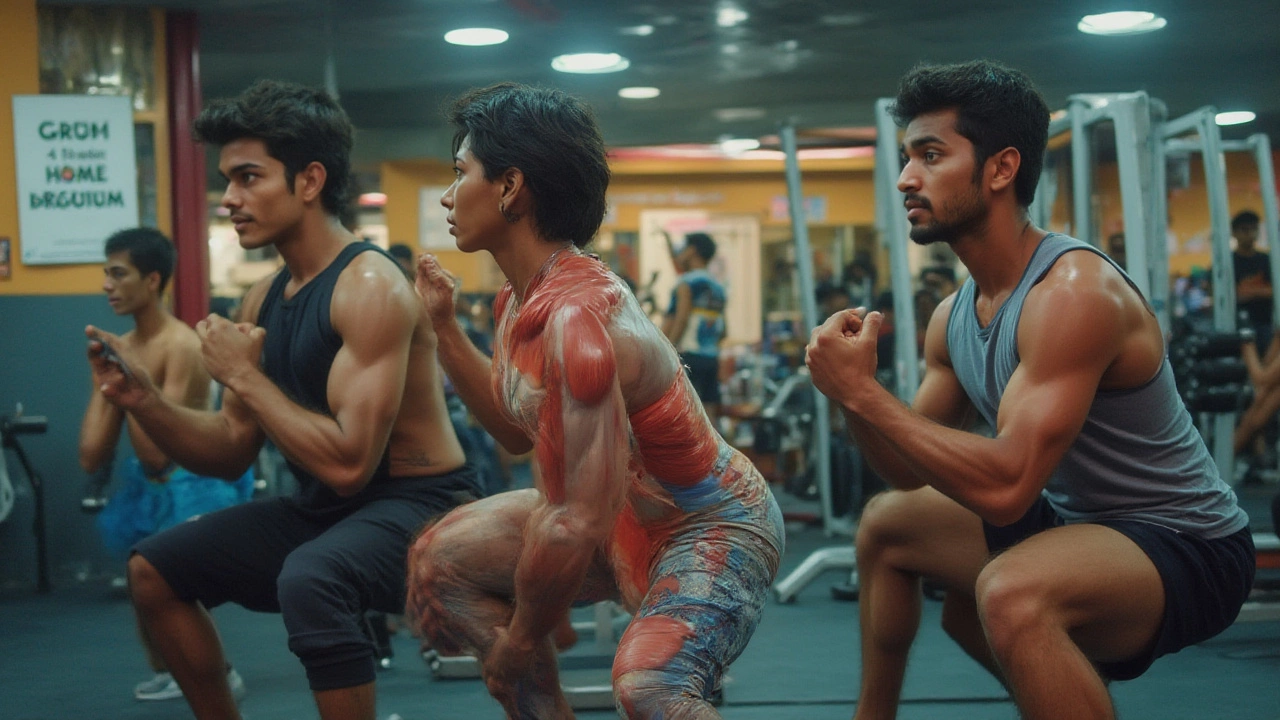Sit down, stand up. Think about how many times your body does that in a given day. It’s basically the same motion as a squat, which might be why this king-of-the-lifts gets so much hype. You’ll hear athletes rave about squats building muscle everywhere, and fitness influencers call them the ultimate test of strength. But are squats really a full-body exercise, or is that just wishful thinking from folks who really don’t want to do upper body day? The answer isn’t as black-and-white as most gym bros make it sound—and it’s wilder than you might expect.
Squat Anatomy: Muscles Fired Up By Every Rep
Let’s break down what your body’s actually doing during a squat. First, there’s the quads—these muscles on the front of your thighs are the main engines driving you up from the bottom of a deep squat. Next is the butt, or more officially, the gluteus maximus. The glutes are like the co-captain catching you if your quads start lagging. Hamstrings on the back of your thighs handle the lowering part—think of them as the brakes on a rollercoaster. And those are just the big players.
Go deeper, and you’ll find calves helping stabilize your ankles, adductor muscles (inside your thighs) keeping your knees from caving in, and the hard-working erector spinae running along your spine, keeping your torso upright. Even your abs get torched, especially if you’re keeping good form. A research team at the University of South Carolina tracked muscle engagement with EMG sensors during standard barbell squats. Not surprisingly, they found sky-high activation for quads, glutes, hamstrings, and significant firing in core muscles—particularly the obliques and rectus abdominis. Shoulders, upper back, and arms join the party too if you’re holding a heavy bar. That’s a muscle lineup fit for an action movie cast.
Check this out:
| Muscle Group | Activation During Standard Squat |
|---|---|
| Quadriceps | Very high |
| Glutes | Very high |
| Hamstrings | Moderate to high |
| Adductors | Moderate |
| Calves | Moderate |
| Core (Abs & Obliques) | Moderate |
| Lower Back | Moderate |
| Upper Back & Shoulders (with barbell) | Light to moderate |
Notice what’s missing? Biceps and triceps aren’t really in the game. Neither are the chest muscles, unless you use a specialty bar or kettlebell squat. That’s the rub: squats *feel* like a whole-body challenge, but they leave some areas out in the cold.
Compound Movement Power: Why Squats Are Called Full-Body
If you’ve ever seen a powerlifter knock out a set of heavy back squats, you know it’s nothing like a leg press at the gym. Squatting demands coordination from head to toe. That’s what makes it a compound exercise—the kind that uses multiple joints and more than one muscle group at the same time. Unlike isolation moves (think leg curls or biceps curls), compounds force your body to stabilize, balance, and brace, all in one explosive package.
Here’s a fun fact: researchers noticed that performing a heavy squat floods your body with hormone surges. Yep, doing squats can bump up both testosterone and growth hormone. This isn't just gym folklore—Swedish scientists ran a trial with elite lifters in 2010. They found testosterone rose nearly 25% just 15 minutes after lifters finished a tough squat set. Why does this matter? Testosterone doesn’t just help with muscle growth in the legs; the theory is that higher hormone levels could help all muscles repair and grow, contributing to your progress both above and below the belt.
If you’re holding weight (a barbell, dumbbell, or kettlebell), your grip, your shoulders, and your upper back are working harder than they would during, say, a standard crunch. Your core goes way beyond sit-up territory; stabilizing a heavy squat hammers the deep muscles that keep your middle strong, way better than any plank marathon. In essence, squats force nearly every muscle from your neck to your ankles to join the effort, which helps explain why they’re chalked up as a do squats work full body move.
But remember our earlier EMG study? While squats torch a lot of muscle at once, there’s still a clear emphasis below the waist. Hands and arms hold—but they don’t press, pull, or curl. Chest muscles assist in balance, but don’t do any pushing. So while your body stabilizes as a whole, not every body part moves as the main engine. Think “full-body involvement,” not “full-body development.”

The Secret Squat Benefits Most People Miss
The basic squat has more to offer than you probably think. It’s not just about building thighs you could crack walnuts with. The real secret is the upgrade to everyday movement. Squats basically train your body for real life: getting up off the floor, picking up groceries, or, let’s face it, landing a perfect park bench sit. Training these patterns actually reduces your risk of injuries outside the gym. According to a 2023 report in the British Journal of Sports Medicine, adults who could do 40+ consecutive bodyweight squats had a much lower risk of falling—or breaking a bone—over the next decade. Your muscles get strong, sure, but your ligaments, bones, and nervous system all get tougher, too.
And here’s something very few folks talk about: squats can be a killer cardio move—and a metabolism booster—when programmed in high reps or as part of a circuit. A 2022 study from the American Council on Exercise found that adding sets of 20-30 full-depth squats to a circuit cranked heart rates nearly as high as running sprints. Your lungs and heart have to work overtime to pump blood to all those big muscle groups. So, in the right setup, squats aren’t just about power—they torch calories and build fitness everywhere.
Squats also boost mobility. A deep squat stretches your hip flexors, opens up your ankles, and loosens your lower back. In cultures where people squat regularly—like parts of Asia—hips stay healthy longer, and rates of lower back pain are lower even in old age. Want to test your mobility? Try holding the “third world squat” (the bottom position) for a solid minute. If your feet flatten and your heels stay down, your hips are happy campers. If not—you’ve got something to work on.
How to Make Squats Work More of Your Body
This is where you can turn the squat into a near-total-body move. The trick? Mix up your variations. Standard back squats are great for lower body and core, but what about upping the full-body demands? Try goblet squats. Holding a heavy dumbbell at your chest activates your biceps, shoulders, and even some pecs to keep the weight stable. Front squats—a favorite in Olympic lifting—move the weight to your collarbone, firing up your upper back and deep core even more.
If you want even more bang for your buck, consider overhead squats. Holding a barbell or weight plate overhead forces your shoulders, triceps, lats, and traps into action just to keep the weight steady. Most beginners struggle to get below parallel on these, not for lack of leg strength, but because their upper bodies and cores aren’t up to the challenge. That’s about as close to a “full-body squat” as you can get.
Don’t forget Bulgarian split squats (one leg back on a bench), which ramp up balance, stability, and core engagement. Add in jump squats for explosive power and sweet calorie burn, or try suitcase squats with a heavy dumbbell in one hand for extra anti-rotational core work. In short: there’s no law saying you have to stick to one squat style. Keep challenging different muscles by switching your stance, load, and tempo. Your progress—and your body—will thank you.
- Use front squats or goblet squats to work upper back, biceps, and core more intensely.
- Try overhead squats for the ultimate whole-body challenge. Start light!
- Incorporate jump or split squats for athleticism and coordination.
- Vary your stance and foot angle to focus on different muscles—wide stance targets adductors; narrow stance hammers quads.
- Don’t forget single-leg variations for improved balance and hip stability.

Tips for Maximizing Gains (and Avoiding Pain)
Doing a squat wrong is easy, and doing it right can make your entire body stronger and more injury-proof. So let’s make your reps count. First, check your depth—try to get your hips at least parallel to your knees. If your knees crackle or your back rounds at the bottom, lighten the load and focus on mobility. The best squats are safe, smooth, and under control, not a rushed bounce at the bottom. To spare your knees, push them out (not in) as you descend, keeping your weight balanced through your whole foot (not just your toes).
Worried about your back? Keep your chest proud, shoulders down, and core tight—think about trying to “break the bar over your back” to engage your lats (especially with a barbell). If flexibility in your ankles limits your depth, let your heels rest on small plates or an angled platform. This tiny tweak helps tons of people unlock a full, pain-free squat. Don’t rush heavy weights. Add load gradually as your form and strength improve.
- Warm up hips and ankles before every squat day. Think bodyweight squats, lunges, and hip circles.
- Film a set every couple weeks—you’ll spot bad habits better than in the mirror.
- Prioritize control. If you can’t pause at the bottom for a one-count, reduce the weight and master the pattern first.
- Change it up—swap in split squats, goblet squats, or sumo squats every month to keep the gains coming and avoid overuse.
- If pain persists, skip the ego—not the squat—and talk through your mechanics with a coach or physical therapist.
Your body’s built to squat. Use it. Play with variations, change the weight, don’t neglect mobility—and you’ll get the full-body dividends you’ve always heard about… including some you never expected.
